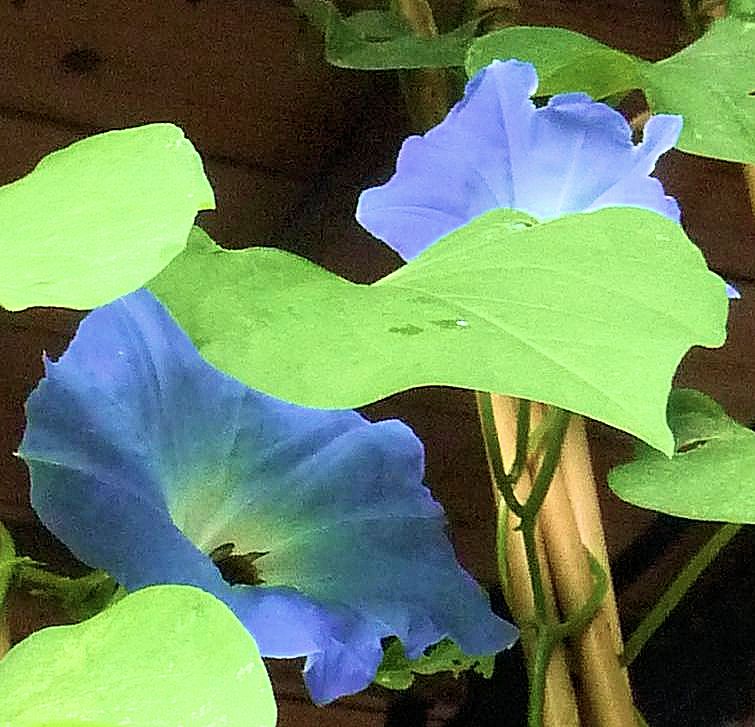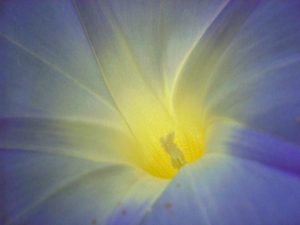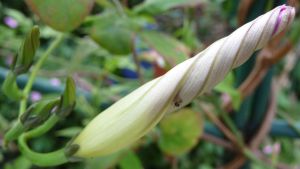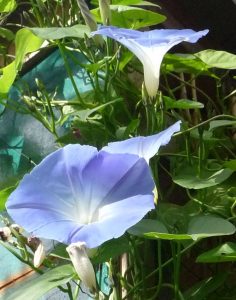MORNING GLORY (Ipomoea tricolor) ‘Heavenly Blue’
 South & Central America
South & Central America
Also known as The Mexican Morning Glory, this elegant annual has heart-shaped leaves, SKY BLUE trumpet-shaped flowers with CREAM throats, & buds that resemble furled satin umbrellas. Flowers of this climber open in early morning, lasting only for a day or part of a day. The plant prefers moist but well drained soil. In our climate, Ipomoeas bloom from springtime till first frosts.
“I. Tricolor does not tolerate temperatures below 5 degrees C (41 degrees F)“ Wikipedia
Ipomoea has its cultivars. RF, our gardener, grew one that was deep blue with purple stripes and another that was crimson. The most striking of all his Morning Glories was ‘Heavenly Blue’, whose flowers are a vivid sky blue.
Cultural and Historical
“The Morning Glory has a rich, historical tradition in psychedelic and visionary practices across multiple cultures, including those of the Chontal Indians of Oaxaca, Mexico, and the highly evolved Aztecs. These seeds, without question, have been utilized throughout time as a means of communicating with the gods.”
Entheology.org – Preserving Ancient Sacred Knowledge
“Morning glories were greatly respected by the ancient Mayans, Aztecs and Native American tribes of Mexico for the spiritual properties they were believed to possess. The seeds were used for vision quests and to communicate with the gods because of their psychoactive properties. The Aztecs believed that plants had spirits and certain plants, like peyote, salvia and morning glory, had special spirits that could directly communicate with the gods. Similarly, the Chental and Mazatec Indian tribes believed that a highly evolved spirit lived in morning glories.”
Other names for Ipomoea purpurea (common blue morning glory) in Central America: Bajicillo: Little tendril, La’aja Shnash: seeds of the Virgin, Mantos de cielo: coat of heaven, Ma’sung Pahk: bones of the children, Mehen Tu’Xikin: little stink ear, Pih Pu’ucte’sh: flower of broken plates, Quiebraplato: breaker of plates.”
Bees’ Favourite.
On summer days, bumblebees & other pollinators drift slowly from one flower to the next, disappearing into the trumpets.
Problems
The annual Ipomoea Tricolor ‘Heavenly Blue’ is one of 3,000 species of ipomoea. In climates that are frost-free, many of these are perennial & can be invasive.
Ipomoea seeds are said to be hallucinogenic and/or poisonous. The plant itself, in a climate which it finds agreeable, can become a thug, seeding prolifically & twining enthusiastically round anything within reach. On one website a gardener tells of planting Morning Glory seeds in his garden; flowers lasted for a season, & the plant shed seed. A few years later he is pulling out new plantlets from other parts of the garden, where the seed had been blown by the wind. In our garden, any seeds produced by Morning Glories always disappear, eaten by wildlife.
MG ‘Heavenly Blue’ at Highbury
Our first gardener RF raised Morning Glories from seed in his airing cupboard. He kept a gardening journal, recording which plants were in flower, the date, when he acquired a plant, the weather, plant problems & solutions.
His father grew Morning Glories in his greenhouse. When father & son spoke on the phone in summer, they compared Morning Glory numbers in bloom that day: ‘The MG Count.’ Sussex greenhouse vs North London cane pergola ‘Heavenly Blues’…. RF consulted his journals to compare the MG tally from previous years with today’s numbers. ‘Twenty-three today!’
The flowers are delicate, & damaged by rain. Often it will rain in the morning, just as the MGs are unfurling. In this small garden, where the unfurling of every Morning Glory is greeted as a cause for celebration, it is crushing to find that some unforgiving downpour has trashed some of the flowers. For several years our Morning Glory trellis was shaped like an ice cream cone… It had a circular awning (metal wire with thick plastic stretched over it). When rain was forecast the awning was attached to the top of the trellis to give the flowers a chance of survival. This often worked.
MGs at Risk from Slugs & Snails

 When RF stopped using the blue snail pellets, slugs & snails moved in & savaged any Morning Glories he planted out in the ground. His solution was to plant them in pots & hang them on the rose arch (successor to the cane pergola), wrapping copper tape round its uprights, close to the ground.
When RF stopped using the blue snail pellets, slugs & snails moved in & savaged any Morning Glories he planted out in the ground. His solution was to plant them in pots & hang them on the rose arch (successor to the cane pergola), wrapping copper tape round its uprights, close to the ground.
I now also use small bits of copper pipe, left after a plumbing job. An electric charge is said to surge through the slug or snail as they come into contact with copper, making them drop off.
Lockdown Morning Glories 2020
This spring, because of Lockdown, there was no garden centre with Anne for ready-grown Morning Glories. An opened packet of Ipomoea ‘Heavenly Blue’ seeds was found amongst some garden guff. It was internet advice (the Damp Paper Towel Method) that coaxed some of those vintage seeds to life.
 Weeks of mollycoddling the young plantlets followed. Keeping the paper towels from drying out, watering just enough & not too much, etc. Once there were four true leaves on each of several young vines, the plants were ready to go outside.
Weeks of mollycoddling the young plantlets followed. Keeping the paper towels from drying out, watering just enough & not too much, etc. Once there were four true leaves on each of several young vines, the plants were ready to go outside.
Lockdown eased enough to allow a walk to local shops ; the hardware store had eight foot canes. A few layers of bricks were laid out in a sunny spot next to the shed. Engineering bricks support the canes; garden twine holds them to the wooden strut at the top. This structure can come down when the Morning Glories have succumbed to frosts.
Would visiting birds, cats, foxes & rodents interfere with the morning glories? Would a heatwave stop them flowering?
In the intense heat of this summer, watering has been crucial. The plants have often been watered twice a day..
The flower is called Morning Glory for a reason. Some blooms may not have opened by 6.30am, & be closed by noon. Larks & early pollinators among us will love these Heavenly Blues – owls, waking later & finding the day’s flowers already closed, may be disappointed.
17th August
Mice have now found the Morning Glories, climbed up the canes & eaten many buds. *#@!!!?!
Those Morning Glories flowering under the plastic overhang stay open longer than those blooming halfway down the canes. Even the MGs facing into the shed may last until dusk.
If only RF’s father had made videos of himself growing Morning Glories in his greenhouse.
How long can Morning Glories continue flowering in a greenhouse or conservatory?
https://www.gardenersworld.com/plants/ipomoea-tricolor-heavenly-blue


























